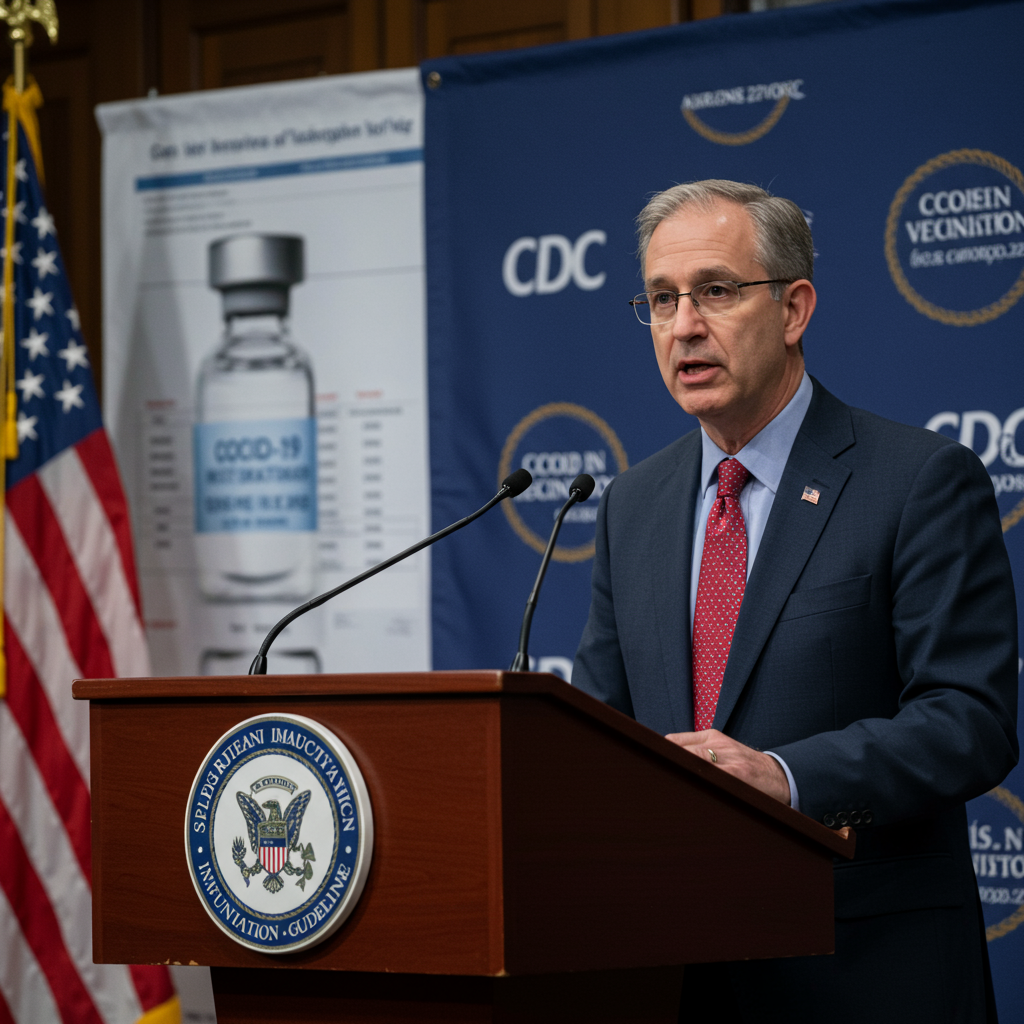The Centers for Disease Control and Prevention (CDC) has unveiled pivotal shifts in its immunization guidelines, marking a significant evolution in U.S. public health policy. These CDC vaccine updates, taking effect on October 7, 2025, move away from universal recommendations for COVID-19 vaccinations. They also introduce a modified approach to childhood immunizations, specifically for the measles, mumps, rubella, and varicella (MMRV) combined vaccine. This comprehensive overhaul signals a new era of personalized healthcare decisions, urging individuals to engage in thoughtful discussions with their doctors.
The new guidance, shaped by the CDC’s Advisory Committee on Immunization Practices (ACIP), represents the most substantial revision since the pandemic’s onset. For many, understanding these changes is crucial for informed health choices. This article delves into the specifics of these updates, their underlying reasons, and what they mean for you and your family.
A New Era for COVID-19 Vaccine Guidance
A core aspect of the CDC vaccine updates is the complete withdrawal of the universal recommendation for COVID-19 vaccines for individuals aged 6 months and older. This unanimous ACIP decision replaces the previous blanket advice with a personalized vaccine decision-making approach. Acting Director of the CDC, Jim O’Neill, emphasized this shift, stating, “Informed consent is back.” He highlighted that the prior “blanket recommendation for perpetual COVID-19 boosters deterred health care providers from talking about the risks and benefits of vaccination for the individual patient or parent.” That policy, he affirmed, is now changing.
The new guidance encourages doctors and patients to make choices based on individual health profiles, specific risks, and potential benefits. While anyone 6 months or older can still opt for a vaccine, the focus is now on those at increased risk for severe COVID-19. This includes individuals aged 65 and older or younger Americans with underlying health conditions. This move follows the U.S. Food and Drug Administration’s (FDA) earlier narrowing of marketing authorization for updated COVID-19 vaccines to these specific high-risk groups.
Informed Consent and Risk Communication Take Center Stage
Crucially, the ACIP also voted overwhelmingly to recommend that the CDC update its language concerning potential risks and uncertainties associated with COVID-19 vaccines. Healthcare providers are now advised to communicate these risks and benefits on an individual basis. The ACIP’s COVID workgroup proposed promoting consistent and comprehensive informed consent processes. These should include accessible language detailing at least six specific risks and uncertainties. They also advocated for enhanced national efforts to diagnose and care for individuals who experience vaccine injuries. This aligns with stated initiatives from Health and Human Services Secretary Robert F. Kennedy Jr. on vaccine injury support.
During ACIP meetings, significant debates arose regarding vaccine efficacy and safety. Experts like Dr. Robert W. Malone questioned “well-defined, characterized correlates of protection” for COVID-19. Other members, such as Dr. Cody Meissner, countered with data demonstrating vaccine effectiveness against severe illness, hospitalizations, and deaths. These discussions underscore the complexity and evolving understanding surrounding vaccine science. Despite the shifting recommendations, major insurers have confirmed continued coverage for COVID-19 vaccine costs through at least 2026. This ensures access remains a priority, regardless of personal choice.
Redefining Childhood Vaccinations: The MMRV Decision
Beyond COVID-19, the immunization schedule for young children also sees significant revisions. The ACIP voted to no longer recommend the combined measles, mumps, rubella, and varicella (MMRV) vaccine as the first dose for children around 12 months old. Instead, children in this age group should receive two separate shots. One shot will be for the combined MMR vaccine, and a second, distinct shot will be for chickenpox (varicella). The MMRV combination shot remains an option for a child’s second dose, typically administered between 4 and 6 years of age.
This change directly addresses a specific, albeit rare, concern. The CDC stated these new recommendations stem from studies suggesting a slightly increased risk of febrile seizures among toddlers receiving the combo shot. Data indicated approximately 8 out of every 10,000 children given the MMRV vaccine experienced febrile seizures. This compares to about 4 out of every 10,000 given separate MMR and varicella shots. While this risk is relatively low, the ACIP deemed it significant enough to alter the initial dosage recommendation. Merck, the manufacturer of the MMRV shot, noted that this advisory panel’s vote occurred “in the absence of new scientific data and in contrast to years of evidence affirming the current immunization schedule.” Access to these separate vaccines is assured under the Vaccines for Children (VFC) program.
The Role of ACIP and Public Health Dialogue
The recent ACIP meetings, which led to these wide-ranging changes, have drawn considerable attention. This is partly due to significant shifts in its membership. Health and Human Services Secretary Robert F. Kennedy Jr. dismissed all 17 previous members in June. Many of the 12 new advisers subsequently appointed have previously expressed vaccine-skeptic views. This new composition has undoubtedly influenced the direction of the committee’s recommendations.
Historically, ACIP recommendations are almost always accepted by the CDC Director, shaping national public health policy. However, the current environment is marked by heightened scrutiny. The American Academy of Pediatrics (AAP), for instance, now “strongly recommends” COVID-19 vaccinations for children aged 6 months to 2 years. This stance directly contrasts with the new CDC guidance and marks the first time in 30 years that AAP’s recommendations have diverged from the U.S. government’s. Such divergences highlight a complex and evolving dialogue within the medical community. They also reflect a broader societal conversation about vaccine policy and public trust. These shifts from universal recommendations to shared clinical decision-making could significantly influence future vaccine uptake and public confidence.
Beyond COVID and MMRV: A Glimpse at Other Discussions
During its recent sessions, ACIP also discussed other immunization topics, reflecting a comprehensive review of the national immunization schedule. Notably, the committee voted unanimously to recommend that all pregnant women be tested for hepatitis B infection. This aims to reduce mother-to-child transmission. However, a contentious vote regarding the pediatric hepatitis B vaccine schedule, specifically delaying the universal birth dose for infants of mothers testing negative, was tabled. Concerns about “gaps in what we know” and “insufficient discussion” led to its postponement. This decision highlights the rigorous, and sometimes challenging, deliberation involved in establishing public health guidelines, especially when balancing perceived risks with established benefits and a history of disease control.
What These Changes Mean for You
These significant CDC vaccine updates represent a pivot in U.S. public health strategy. The move towards individual-based decision-making for COVID-19 vaccines empowers patients and parents. It places greater emphasis on direct conversations with healthcare providers. For childhood immunizations, the adjusted MMRV recommendation prioritizes minimizing even rare risks, albeit with a slight increase in the number of shots given at one visit.
This new approach underscores the importance of informed dialogue. Patients are encouraged to speak openly with their doctors. Discuss your individual health circumstances, potential benefits, and any concerns you may have before deciding on immunizations. Understanding these policy changes helps ensure you make the best health decisions for yourself and your family. Public health experts continue to stress the overall safety and effectiveness of vaccines in preventing severe illness, hospitalization, and death, while acknowledging the need for tailored advice.
Frequently Asked Questions
What specifically changed with CDC’s COVID-19 vaccine guidance?
The CDC officially dropped its universal recommendation for COVID-19 vaccines for all individuals aged 6 months and older. Instead, the new guidance emphasizes “individual-based decision-making.” This means that while vaccines remain available, the decision to get vaccinated, particularly for those not at high risk, is now a personal choice made in consultation with a healthcare provider, considering individual risks and benefits.
How does the new MMRV guidance affect childhood immunization schedules?
For toddlers around 12 months old receiving their first dose, the CDC now recommends separate measles, mumps, and rubella (MMR) and varicella (chickenpox) shots. This replaces the combined MMRV vaccine for the initial dose. The MMRV shot remains an option for a child’s second dose, typically given between 4 and 6 years of age. This change addresses a rare, slightly increased risk of febrile seizures observed with the combined shot.
What does “individual-based decision-making” mean for my vaccine choices?
“Individual-based decision-making” for vaccines, particularly for COVID-19, means that broad, universal recommendations are being replaced by a personalized approach. It encourages you to discuss your specific health status, age, risk factors, and any underlying conditions with your doctor. Together, you and your healthcare provider can assess the potential benefits and risks of vaccination for your unique situation, helping you make an informed choice that best suits your needs.
Conclusion
The latest CDC vaccine updates herald a profound shift in public health strategy, prioritizing personalized care and informed consent. From the new COVID-19 vaccine guidance favoring individual decision-making to the revised MMRV vaccine risks considerations, these changes reflect evolving scientific understanding and societal dialogue. While the landscape of vaccine recommendations continues to adapt, the central message remains clear: open communication with your healthcare provider is paramount. This ensures that you receive guidance tailored to your health profile, helping you navigate these critical choices with confidence and clarity. Staying informed is the first step towards making responsible health decisions for yourself and your community.




